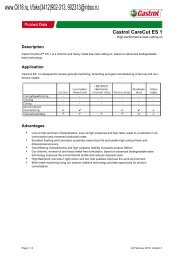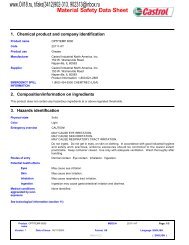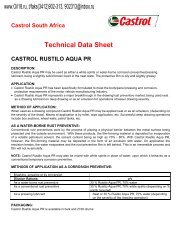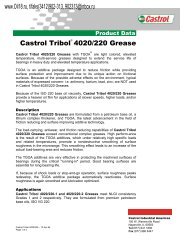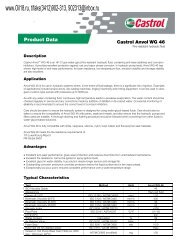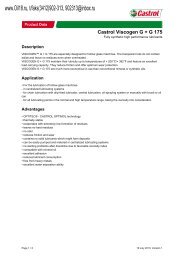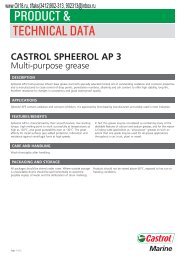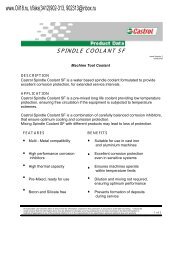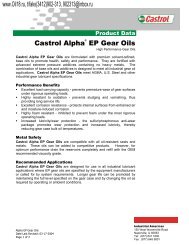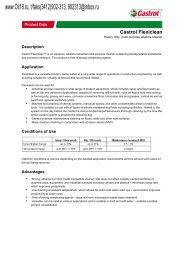9468 Hysol GS (English (GB)) BP EU SDS - United Kingdom [UK ...
9468 Hysol GS (English (GB)) BP EU SDS - United Kingdom [UK ...
9468 Hysol GS (English (GB)) BP EU SDS - United Kingdom [UK ...
You also want an ePaper? Increase the reach of your titles
YUMPU automatically turns print PDFs into web optimized ePapers that Google loves.
SAFETY DATA SHEET<br />
www.Oil18.ru, t/faks(3412)902-313, 902313@inbox.ru<br />
1 . Identification of the substance/preparation and company/undertaking<br />
Product name<br />
<strong>SDS</strong> no.<br />
Historic <strong>SDS</strong> no.<br />
Product use<br />
Supplier<br />
<strong>Hysol</strong> <strong>GS</strong><br />
454182<br />
<strong>UK</strong>-7044<br />
Metalworking fluid - soluble.<br />
Castrol (U.K.) Limited<br />
Wakefield House<br />
Pipers Way<br />
Swindon<br />
Wiltshire, SN3 1RE<br />
<strong>United</strong> <strong>Kingdom</strong><br />
EMERGENCY TELEPHONE<br />
NUMBER<br />
Tel.: +44 (0)1793 512712<br />
Fax.: +44 (0)1793 486083<br />
Carechem: +44 (0) 208 762 8322<br />
2 .<br />
Composition/information on ingredients<br />
Highly refined mineral oil, emulsifiers and additives.<br />
Chemical name<br />
CAS no. % EINECS / ELINCS. Classification<br />
Rape diethanolamide 68187-80-4 5 - 10 269-125-8 Xi; R38, R41<br />
Amine neutralised carboxylic acids 67939-53-1 1 - 5 267-841-5 Xi; R36/38<br />
N,N - methylene bismorpholine 5625-90-1 1 - 5 227-062-3 Xn; R22<br />
C; R34<br />
R52<br />
Ethylene glycol; ethanediol 107-21-1 1 - 5 203-473-3 Xn; R22<br />
polyethylene glycol monooleyl ether 9004-98-2 1 - 5 500-016-2 Xn; R22<br />
Xi; R41<br />
(z)-docos-13-enoic acid, compound with 2-aminoethanol 84099-98-9 1 - 5 282-078-8 Xi; R36/38<br />
(1:1)<br />
3-Iodo-2-propynyl butylcarbamate 55406-53-6 0.1 - 1 259-627-5 Xn; R20/22<br />
Xi; R41<br />
N; R50<br />
See section 16 for the full text of the R-phrases declared above<br />
Occupational exposure limits, if available, are listed in section 8.<br />
3 .<br />
Hazards identification<br />
This preparation is classified as dangerous according to Directive 1999/45/EC as amended and adapted.<br />
Not classified as dangerous when diluted below 40%.<br />
Physical/chemical hazards Not classified as dangerous.<br />
Human health hazards<br />
Environmental hazards<br />
Effects and symptoms<br />
Eyes<br />
Skin<br />
Inhalation<br />
Ingestion<br />
Risk of serious damage to eyes.<br />
Not classified as dangerous.<br />
Causes eye irritation.<br />
Prolonged or repeated contact can defat the skin and lead to irritation and/or dermatitis.<br />
Vapours and aerosol can produce mucous membrane, nose and throat irritation.<br />
Ingestion may cause gastrointestinal irritation and diarrhoea.<br />
Product name <strong>Hysol</strong> <strong>GS</strong><br />
Product code<br />
454182-<strong>GB</strong>03<br />
Version 3 Date of issue 24 February 2006<br />
Format <strong>United</strong> <strong>Kingdom</strong> Language<br />
(<strong>UK</strong>)<br />
Build 7.2.6 (<strong>United</strong> <strong>Kingdom</strong>)<br />
Page: 1/5<br />
ENGLISH<br />
( ENGLISH )
4 .<br />
First-aid measures<br />
Eye contact<br />
Skin contact<br />
Inhalation<br />
Ingestion<br />
In case of contact, immediately flush eyes with a copious amount of water for at least 15 minutes. Obtain<br />
medical attention immediately.<br />
Wash contaminated skin with soap and water. Remove contaminated clothing and shoes. Wash clothing<br />
before reuse. Clean shoes thoroughly before reuse. Get medical attention if irritation develops.<br />
If inhaled, remove to fresh air. Get medical attention if symptoms appear.<br />
Do NOT induce vomiting unless directed to do so by medical personnel. Never give anything by mouth to<br />
an unconscious person. Wash out mouth with water if person is conscious. If large quantities of this<br />
material are swallowed, call a physician immediately.<br />
5 .<br />
Fire-fighting measures<br />
Extinguishing media<br />
Suitable<br />
Not suitable<br />
Hazardous decomposition<br />
products<br />
Unusual fire/explosion hazards<br />
Special fire-fighting<br />
procedures<br />
Protection of fire-fighters<br />
In case of fire, use water fog, foam, dry chemical or carbon dioxide extinguisher or spray. Fire water<br />
contaminated with this material must be contained and prevented from being discharged to any waterway,<br />
sewer or drain.<br />
Do not use water jet.<br />
These products are carbon oxides (CO, CO2), nitrogen oxides (NO, NO2 etc.). Some metallic oxides.<br />
This material is not explosive as defined by established regulatory criteria.<br />
None identified.<br />
Fire-fighters should wear self-contained positive pressure breathing apparatus (SCBA) and full turnout<br />
gear.<br />
6 . Accidental release measures<br />
Personal precautions<br />
Environmental precautions<br />
and clean-up methods<br />
Personal protection in case of<br />
a large spill<br />
Immediately contact emergency personnel. Keep unnecessary personnel away. Use suitable protective<br />
equipment (See Section: "Exposure controls/personal protection"). Follow all fire fighting procedures (See<br />
Section: "Fire-fighting measures").<br />
If emergency personnel are unavailable, contain spilled material. For small spills add absorbent (soil may<br />
be used in the absence of other suitable materials) scoop up material and place in a sealed, liquid-proof<br />
container for disposal. For large spills dike spilled material or otherwise contain material to ensure runoff<br />
does not reach a waterway. Place spilled material in an appropriate container for disposal. Avoid contact<br />
of spilt material with soil and prevent runoff entering surface waterways. See Section 13 for Waste<br />
Disposal Information.<br />
Splash goggles. Full suit. Boots. Gloves. Suggested protective clothing might not be sufficient; consult a<br />
specialist BEFORE handling this product.<br />
7 .<br />
Handling and storage<br />
Handling<br />
Storage<br />
Do not get in eyes. Avoid breathing vapour or mist. Avoid prolonged or repeated contact with skin. Avoid<br />
contact of spilled material and runoff with soil and surface waterways. Wash thoroughly after handling.<br />
Keep container tightly closed. Keep container in a cool, well-ventilated area. Protect from freezing.<br />
8 . Exposure controls/personal protection<br />
Ingredient name<br />
Distillates (petroleum), hydrotreated, light naphthinic<br />
(Highly refined mineral oil)<br />
Ethylene glycol; ethanediol<br />
Occupational exposure limits<br />
EH40-OES (<strong>United</strong> <strong>Kingdom</strong> (<strong>UK</strong>)).<br />
STEL: 10 mg/m 3 15 minute(s). Form: Oil mist, mineral<br />
TWA: 5 mg/m 3 8 hour(s). Form: Oil mist, mineral<br />
EH40-WEL (<strong>United</strong> <strong>Kingdom</strong> (<strong>UK</strong>), 1/2005). Skin<br />
STEL: 104 mg/m 3 15 minute(s).<br />
STEL: 40 ppm 15 minute(s).<br />
TWA: 52 mg/m 3 8 hour(s).<br />
TWA: 20 ppm 8 hour(s).<br />
Boric acid ACGIH TLV (<strong>United</strong> States, 1/2005).<br />
STEL: 6 mg/m 3 15 minute(s).<br />
TWA: 2 mg/m 3 8 hour(s).<br />
Where there are no regulatory exposure limits, for information and guidance, the ACGIH values are included.<br />
For further information on these please consult your supplier.<br />
Whilst specific OELs for certain components are included in this <strong>SDS</strong>, it should be noted that other components of the preparation will be<br />
present in any mist, vapour or dust produced. For this reason, the specific OELs may not be applicable to the product and are provided for<br />
guidance purposes.<br />
Product name <strong>Hysol</strong> <strong>GS</strong><br />
Product code<br />
454182-<strong>GB</strong>03<br />
Version 3 Date of issue 24 February 2006<br />
Format <strong>United</strong> <strong>Kingdom</strong> Language<br />
(<strong>UK</strong>)<br />
Build 7.2.6 (<strong>United</strong> <strong>Kingdom</strong>)<br />
Page: 2/5<br />
ENGLISH<br />
( ENGLISH )
This product contains a preservative that may release trace amounts of formaldehyde during use.<br />
Control Measures<br />
Hygiene measures<br />
Personal protective equipment<br />
Respiratory system<br />
Provide exhaust ventilation or other engineering controls to keep the relevant airborne concentrations<br />
below their respective occupational exposure limits. Local exhaust ventilation is preferred because it<br />
prevents contaminant dispersion into the work area by controlling it at its source.<br />
Wash hands, forearms and face thoroughly after handling chemical products, before eating, smoking<br />
and using the lavatory and at the end of the working period.<br />
None required; however, use of adequate ventilation is good industrial practice.<br />
Skin and body<br />
Hands<br />
Eyes<br />
Wear appropriate clothing to avoid prolonged skin contact.<br />
Wear protective gloves if prolonged or repeated contact is likely.<br />
Chemical resistant gloves. Recommended: nitrile gloves<br />
The correct choice of protective gloves depends upon the chemicals being handled, the conditions of<br />
work and use, and the condition of the gloves (even the best chemically resistant glove will break down<br />
after repeated chemical exposures). Most gloves provide only a short time of protection before they<br />
must be discarded and replaced. Because specific work environments and material handling practices<br />
vary, safety procedures should be developed for each intended application. Gloves should therefore be<br />
chosen in consultation with the supplier/manufacturer and with a full assessment of the working<br />
conditions.<br />
Do not get in eyes. Chemical splash goggles.<br />
9 .<br />
Physical and chemical properties<br />
Flash point<br />
>100 °C (Closed cup)<br />
Pour point 100 °C<br />
13 . Disposal considerations<br />
Disposal Consideration /<br />
Waste information<br />
Hazardous waste<br />
Avoid contact of spilled material and runoff with soil and surface waterways. Consult an environmental<br />
professional to determine if local, regional or national regulations would classify spilled or contaminated<br />
materials as hazardous waste. Use only approved transporters, recyclers, treatment, storage or disposal<br />
facilities. Dispose of in accordance with all applicable local and national regulations.<br />
This product is listed as Hazardous by the <strong>EU</strong> Directive on hazardous waste. Dispose of according to all<br />
national and local applicable regulations.<br />
14 . Transport information<br />
Not classified as hazardous for transport (ADR/RID, ADNR, IMDG, ICAO/IATA)<br />
15 .<br />
Regulatory information<br />
Label requirements<br />
Hazard Symbol(s)<br />
Indication of danger<br />
Risk phrases<br />
Safety phrases<br />
<strong>EU</strong> regulations<br />
Other regulations<br />
Inventories<br />
R41- Risk of serious damage to eyes.<br />
Irritant<br />
S26- In case of contact with eyes, rinse immediately with plenty of water and seek medical advice.<br />
S36/37/39- Wear suitable protective clothing, gloves and eye/face protection.<br />
Classification and labelling have been performed according to <strong>EU</strong> directives 1999/45/EC and<br />
67/548/EEC as amended and adapted.<br />
AUSTRALIAN INVENTORY (AICS): Not determined.<br />
CANADA INVENTORY (DSL): Not listed.<br />
CHINA INVENTORY (IECS): Not determined.<br />
EC INVENTORY (EINECS/ELINCS): In compliance.<br />
JAPAN INVENTORY (ENCS): Not determined.<br />
KOREA INVENTORY (ECL): Not determined.<br />
PHILIPPINE INVENTORY (PICCS): Not listed.<br />
US INVENTORY (TSCA): Not determined.<br />
16 .<br />
Other information<br />
Full text of R-phrases referred<br />
to in sections 2 and 3<br />
History<br />
Date of issue 24/02/2006.<br />
Date of previous issue<br />
Prepared by<br />
Notice to reader<br />
R20/22- Harmful by inhalation and if swallowed.<br />
R22- Harmful if swallowed.<br />
R34- Causes burns.<br />
R36/38- Irritating to eyes and skin.<br />
R38- Irritating to skin.<br />
R41- Risk of serious damage to eyes.<br />
R50- Very toxic to aquatic organisms.<br />
R52- Harmful to aquatic organisms.<br />
08/02/2006.<br />
Product Stewardship<br />
Revision Indicator: The presence of a triangle in the upper left corner of a field indicates a change since the previous version.<br />
Product name <strong>Hysol</strong> <strong>GS</strong><br />
Product code<br />
454182-<strong>GB</strong>03<br />
Version 3 Date of issue 24 February 2006<br />
Format <strong>United</strong> <strong>Kingdom</strong> Language<br />
(<strong>UK</strong>)<br />
Build 7.2.6 (<strong>United</strong> <strong>Kingdom</strong>)<br />
Page: 4/5<br />
ENGLISH<br />
( ENGLISH )
All reasonably practicable steps have been taken to ensure this data sheet and the health, safety and environmental information contained in it is<br />
accurate as of the date specified below. No warranty or representation, express or implied is made as to the accuracy or completeness of the<br />
data and information in this data sheet.<br />
The data and advice given apply when the product is sold for the stated application or applications. You should not use the product other than for<br />
the stated application or applications without seeking advice from us.<br />
It is the user’s obligation to evaluate and use this product safely and to comply with al applicable laws and regulations. The <strong>BP</strong> Group shal not<br />
be responsible for any damage or injury resulting from use, other than the stated product use of the material, from any failure to adhere to<br />
recommendations, or from any hazards inherent in the nature of the material. Purchasers of the product for supply to a third party for use at work,<br />
have a duty to take all necessary steps to ensure that any person handling or using the product is provided with the information in this sheet.<br />
Employers have a duty to tell employees and others who may be affected of any hazards described in this sheet and of any precautions that<br />
should be taken.<br />
Product name <strong>Hysol</strong> <strong>GS</strong><br />
Product code<br />
454182-<strong>GB</strong>03<br />
Version 3 Date of issue 24 February 2006<br />
Format <strong>United</strong> <strong>Kingdom</strong> Language<br />
(<strong>UK</strong>)<br />
Build 7.2.6 (<strong>United</strong> <strong>Kingdom</strong>)<br />
Page: 5/5<br />
ENGLISH<br />
( ENGLISH )




